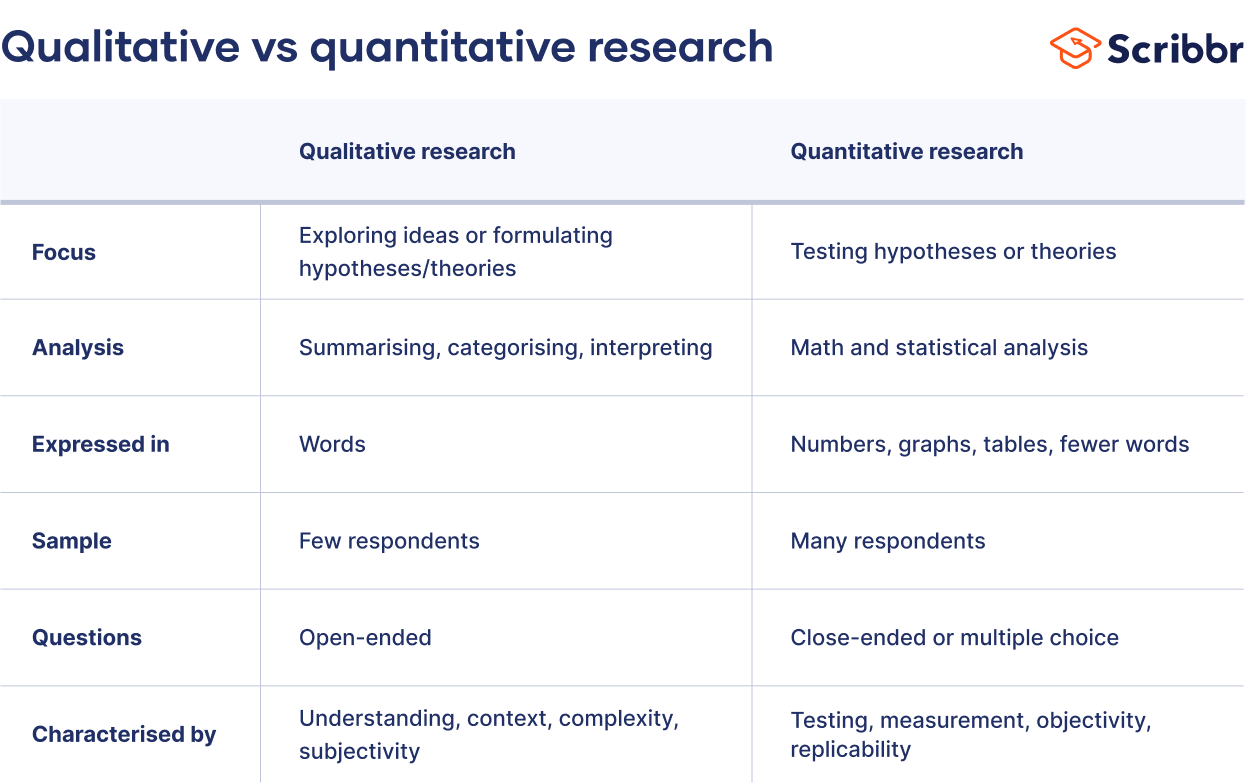Qualitative vs Quantitative Research | Examples & Methods
When collecting and analysing data, quantitative research deals with numbers and statistics, while qualitative research deals with words and meanings. Both are important for gaining different kinds of knowledge.
Common quantitative methods include experiments, observations recorded as numbers, and surveys with closed-ended questions.
Common qualitative methods include interviews with open-ended questions, observations described in words, and literature reviews that explore concepts and theories.
The differences between quantitative and qualitative research
Quantitative and qualitative research use different research methods to collect and analyse data, and they allow you to answer different kinds of research questions.
Data collection methods
Quantitative and qualitative data can be collected using various methods. It is important to use a data collection method that will help answer your research question(s).
Many data collection methods can be either qualitative or quantitative. For example, in surveys, observations or case studies, your data can be represented as numbers (e.g. using rating scales or counting frequencies) or as words (e.g. with open-ended questions or descriptions of what you observe).
However, some methods are more commonly used in one type or the other.
Quantitative data collection methods
- Surveys: List of closed or multiple choice questions that is distributed to a sample (online, in person, or over the phone).
- Experiments: Situation in which variables are controlled and manipulated to establish cause-and-effect relationships.
- Observations: Observing subjects in a natural environment where variables can’t be controlled.
Qualitative data collection methods
- Interviews: Asking open-ended questions verbally to respondents.
- Focus groups: Discussion among a group of people about a topic to gather opinions that can be used for further research.
- Ethnography: Participating in a community or organisation for an extended period of time to closely observe culture and behavior.
- Literature review: Survey of published works by other authors.
When to use qualitative vs quantitative research
A rule of thumb for deciding whether to use qualitative or quantitative data is:
- Use quantitative research if you want to confirm or test something (a theory or hypothesis)
- Use qualitative research if you want to understand something (concepts, thoughts, experiences)
For most research topics you can choose a qualitative, quantitative or mixed methods approach. Which type you choose depends on, among other things, whether you’re taking an inductive vs deductive research approach; your research question(s); whether you’re doing experimental, correlational, or descriptive research; and practical considerations such as time, money, availability of data, and access to respondents.
Quantitative research approach
You survey 300 students at your university and ask them questions such as: ‘on a scale from 1-5, how satisfied are your with your professors?’
You can perform statistical analysis on the data and draw conclusions such as: ‘on average students rated their professors 4.4’.
Qualitative research approach
You conduct in-depth interviews with 15 students and ask them open-ended questions such as: ‘How satisfied are you with your studies?’, ‘What is the most positive aspect of your study program?’ and ‘What can be done to improve the study program?’
Based on the answers you get you can ask follow-up questions to clarify things. You transcribe all interviews using transcription software and try to find commonalities and patterns.
Mixed methods approach
You conduct interviews to find out how satisfied students are with their studies. Through open-ended questions you learn things you never thought about before and gain new insights. Later, you use a survey to test these insights on a larger scale.
It’s also possible to start with a survey to find out the overall trends, followed by interviews to better understand the reasons behind the trends.
How to analyse qualitative and quantitative data
Qualitative or quantitative data by itself can’t prove or demonstrate anything, but has to be analysed to show its meaning in relation to the research questions. The method of analysis differs for each type of data.
Analysing quantitative data
Quantitative data is based on numbers. Simple maths or more advanced statistical analysis is used to discover commonalities or patterns in the data. The results are often reported in graphs and tables.
Applications such as Excel, SPSS, or R can be used to calculate things like:
- Average scores
- The number of times a particular answer was given
- The correlation or causation between two or more variables
- The reliability and validity of the results
Analysing qualitative data
Qualitative data is more difficult to analyse than quantitative data. It consists of text, images or videos instead of numbers.
Some common approaches to analysing qualitative data include:
- Qualitative content analysis: Tracking the occurrence, position and meaning of words or phrases
- Thematic analysis: Closely examining the data to identify the main themes and patterns
- Discourse analysis: Studying how communication works in social contexts
Frequently asked questions about qualitative and quantitative research
Cite this Scribbr article
If you want to cite this source, you can copy and paste the citation or click the ‘Cite this Scribbr article’ button to automatically add the citation to our free Reference Generator.
Streefkerk, R. (2023, May 08). Qualitative vs Quantitative Research | Examples & Methods. Scribbr. Retrieved 29 December 2025, from https://www.scribbr.co.uk/research-methods/quantitative-qualitative-research/
